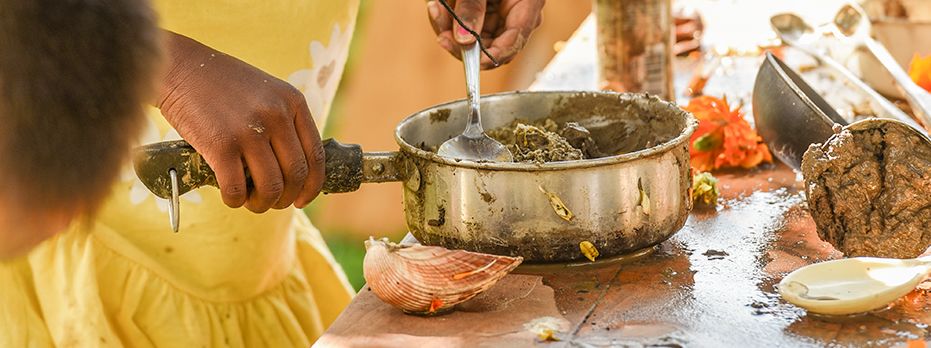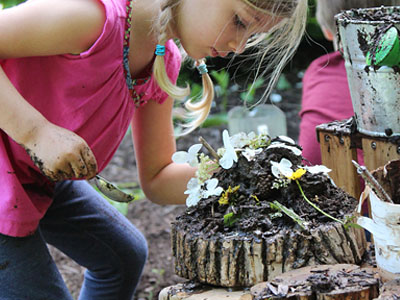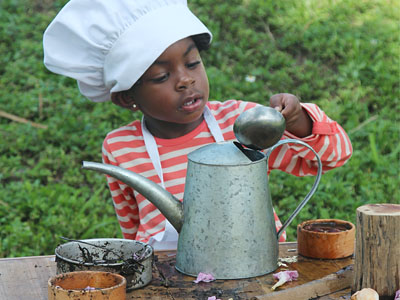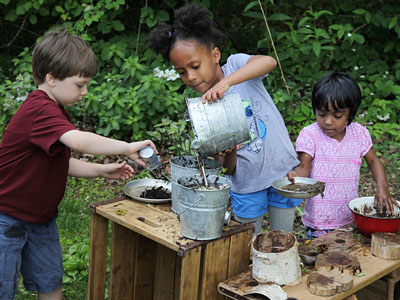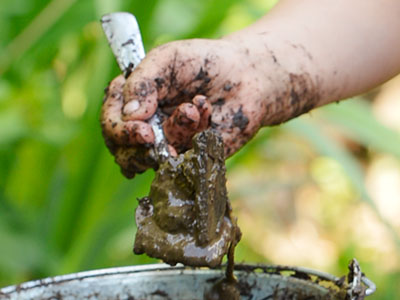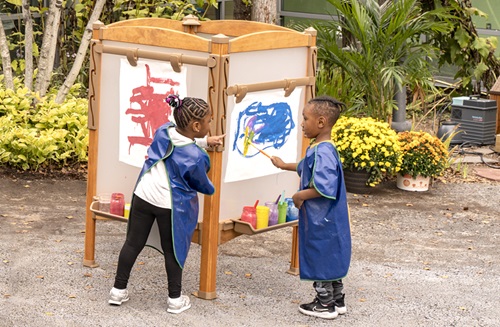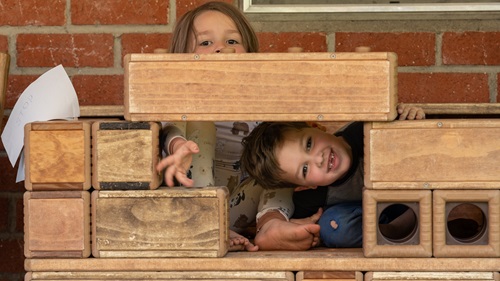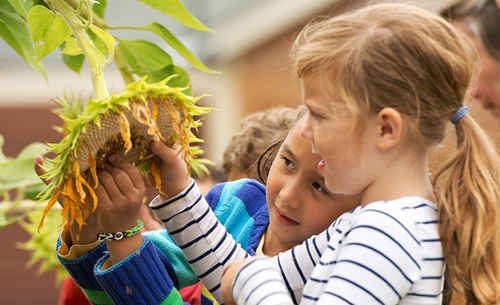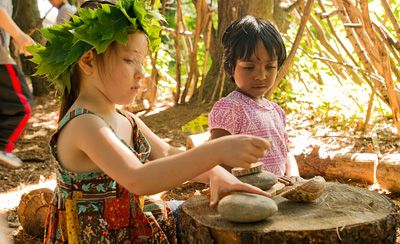Making a Mud Kitchen
| June 2014It’s mud season again and good things are being made. How about a chocolate mud pie, decorated with yellow dandelions? Or a luscious cupcake sprinkled with sand and cherry petals? Finish it off with some soup full of new leaves, tiny twigs, or leftover acorns. Cooking season has begun with creativity, happiness, and generosity from both nature (with abundant loose parts) and children (eager to share a “taste” of their fresh creations).
Dirt, sand, water, bits of plants, and cooking utensils comprise a timeless play kit. The first outdoor environment encountered by an exploring infant is most likely the ground, and probably the dirt: gritty, cool, stony, sandy, smooth to the hand, brown or black or gray to the eye, and tempting to the tongue. The toddler investigates further: “Look what it does with water too-maybe runs away or makes a nice moosh. How about poking it with this stick, hmm, and stirring a bit. Guess what—now I’m making food!” The preschooler in her inventiveness thinks “I can cook dinner!” The stimulating fun can be experienced again and again, up through the early childhood years and beyond. Having a Mud Kitchen makes the process accessible and rich.
"Birthday cake"
Realizing that free play in a nature-rich environment is increasingly less available to young children, many child care centers are installing these ancient play kits in their playgrounds. Some of the values that mud kitchens provide for children include:
- Creative expression and invention (mud can become anything!)
- Problem solving opportunities (e.g. how to make soup thin or thick, how to make mud meatballs stick together)
- Cooperative play possibilities (e.g. let’s cook dinner, let’s have a restaurant, let’s feed the baby—you be the baby)
- Stress reduction (being outdoors in nature helps children relax)
- Building stronger immune systems (research indicates that some exposure to dirt helps build resistance to bad bacteria)
- Growing affection for the stuff on our earth—soil, stones, sand, and growing plants (leading to care for our planet)
Future cook? Or future scientist?
The British scholar and advocate, Jan White, has been spearheading an initiative in the UK to help teachers see the possibilities for play and learning from Mud Kitchens. Her photo-filled booklet, Making a Mud Kitchen-Just Do It! is a PDF which can be downloaded at www.muddyfaces.co.uk. Photos shows how a board between two cinderblocks can be a cooking shelf, how an old microwave can be a great play oven, how leftover pots, pans, strainers, spoons, measuring cups and spoons can be used for fabulous culinary concoctions. In addition she gives suggestions for the site of the kitchen (a semi enclosed space to seem like a real kitchen), protecting children’s clothes, collecting the good variety of utensils needed, providing clean topsoil and sand, ensuring bounteous plant material and a water supply, and keeping everyone and everything clean at the end of the playtime. This is a practical, enticing booklet.
All you need are some old pots and pans
An American child care teacher, Beth Grant, recently experimented with a huge Mud Kitchen in the hot mid-summer, when her children put on bathing suits and had a large scale frolic with all the home corner cooking equipment found in the school—stoves, dishes, pots and pans, utensils, and tubs of water. Hoses were employed to wash off the children at the end of the session. Later in the fall, when bathing suits were put away, she experimented with a Mud Kitchen-Café where a table was set up for restaurant patrons, and cooks and waiters took and fulfilled orders. This play was more decorous and involved more communication skills and role-playing. Now she is organizing a permanent Mud Kitchen in her play space that can be used like any other outdoor center with a few children at a time working there. From her experience Beth offers the following advice:
Work with the teachers. Some teachers are initially resistant to the idea of a mud kitchen, but with guidance, and after seeing one being enjoyed by children, they embrace it. Mud play provides so many opportunities for learning! Textures abound, descriptive language is impossible to avoid, measuring skills are honed, and cause and effect happens right before the children’s eyes and in their hands. It is a fun experience that has learning happening the best way possible—through play! Teachers may need to be reminded to continue the mud kitchen inside the classroom, referencing it and drawing upon it as it relates to other topics or by having the children create journal entries about the experience. Teachers should be encouraged to remember their own childhood mud experiences and they should feel free to join in the fun with the children.
Communicate with the families. Families are often dubious about the idea of mud play. They need to be educated about the benefits and learning opportunities it allows and often need to be reminded that skin is waterproof and that dirt washes off. Families should be encouraged to donate supplies such as pots and pans, cupcake tins, colanders and other durable items for kitchen play. Bags of topsoil are cheap and always in demand once mud kitchen season starts. Loose parts for ingredients are always welcome, whether it is bird seed, pebbles, sawdust, or a bag of beans. Families should have an open invitation to come see the mud kitchen in use or to cook up a treat of their own! Photos can be sent home to those who cannot witness mud play in action and could be accompanied by a note explaining what is going on in the picture and listing the skills being used. An added benefit of this is that the children will have tangible reminder of their experience and a keepsake for the years to come.
Set sensible expectations for the children. Like all interest areas, mud kitchens have some ground rules. In addition to the basics—share, be kind, take turns—a mud kitchen adds: “mud is not for throwing” and “do not eat mud.” The rules should be kept to a minimum and need to be explained before opening the kitchen. Children should be encouraged to leave the kitchen in good condition for the next group of chefs and be shown how to replenish the loose parts and “wash” the dishes in a tub of water—an activity that is almost as fun as the cooking.
Why not give the mud kitchen a try?Enjoy nature’s famous investigation and invention material—mud!
"Want to try some?"
To learn more about Mud Kitchens, read Jan White’s blog at https://janwhitenaturalplay.wordpress.com/tag/mud-kitchens/. And if you really like mud and children together, look into International Mud Day at the World Forum Foundation (www.worldforumfoundation.org). This year it takes place on June 29.

